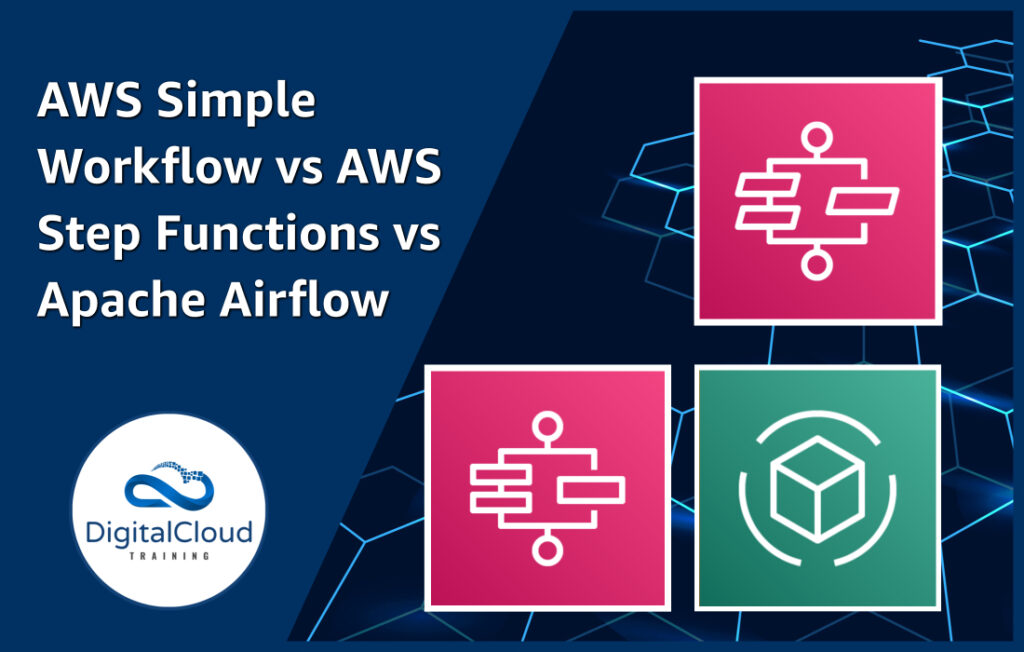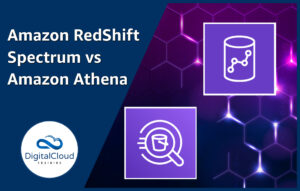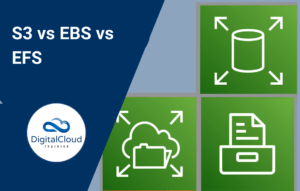AWS Simple Workflow vs AWS Step Functions vs Apache Airflow
Please use the menu below to navigate the article sections:

There are a number of different services and products on the market which support building logic and processes within your application flow. While these services have largely similar pricing, there are different use cases for each service.
AWS Simple Workflow Service (SWF), AWS Step Functions and Apache Airflow all seem very similar, and at times it may seem difficult to distinguish each service. This article highlights the similarities and differences, benefits, drawbacks, and use cases of these services that see a growing demand.
What is AWS Simple Workflow Service?
The AWS Simple Workflow Service (SWF) allows you to coordinate work between distributed applications.
A task is an invocation of a logical step in an Amazon SWF application. Amazon SWF interacts with workers which are programs that retrieve, process, and return tasks.
As part of the coordination of tasks, execution dependencies, scheduling, and concurrency are managed accordingly.
What are AWS Step Functions?
AWS Step Functions enables you to coordinate distributed applications and microservices through visual workflows.
Your workflow can be visualized by state machines describing steps, their relationships, and their inputs and outputs. State machines represent individual steps in a workflow diagram by containing a number of states.
The states in your workflow can perform work, make choices, pass parameters, initiate parallel execution, manage timeouts, or terminate your workflow.
What is Apache Airflow?
Firstly, Apache Airflow is a third party tool – and is not an AWS Service. Apache Airflow is an open-source workflow management platform for data engineering pipelines.
This powerful and widely-used open-source workflow management system (WMS) allows programmatic creation, scheduling, orchestration, and monitoring of data pipelines and workflows.
Using Airflow, you can author workflows as Directed Acyclic Graphs (DAGs) of tasks, and Apache Airflow can integrate with many AWS and non-AWS services such as: Amazon Glacier, Amazon CloudWatch Logs and Google Cloud Secret Manager.
Benefits and Drawbacks
Let’s have a closer look at the benefits and drawbacks of each service.
AWS Simple Workflows pros and cons:
| Advantages | Disadvantages |
| Built in scalability: Amazon SWF seamlessly scales along with your application’s usage. | Limited use cases due to lack of large amounts of features |
| Reliability: Amazon SWF runs at intervals Amazon’s high-availability data centers, therefore the state tracking and task process engine are accessible whenever applications would like them. | Difficult / long time to set up. |
| Easy to Implement: Amazon Simple Workflow eliminates the requirement for developers to manage the infrastructure plumbing of method automation – so they can focus their energy on the distinctive practicality of their application. | Easy to run into rate limiting and throttling issues. |
| Flexibility of use: Amazon Simple Workflow allows the user to modify the application elements. In addition, it modifies coordination logic in any programming language and runs them within the cloud or on-premises. | The API used for searching workflows is very limiting. |
| Logical Separation: AWS SWF separates the control flow of your background job’s stepwise logic along with the actual units of labor which contain the distinctive business logic. This permits you to one by one manage, maintain, and scale “state machinery” of your application from the core business logic that differentiates it. | The AWS management console is dated, and riddled with small bugs and oversights. Lack of general support. |
AWS Step Functions pros and cons:
| Pros | Cons |
| Enables you to easily create complex workflows across multiple services with minimal operational overhead. | Requires you to configure workflows with the proprietary Amazon States Language which is only used with Step Functions. |
| You can manage states between the executions of your stateless functions without having to set up queues or databases. | Although it lets you decouple business logic from your task sequence, this can make your code harder for developers to understand. |
| Enables you to decouple your workflow logic from your business logic, decreasing application complexity. | Step functions and the state machines that define your workflows are only useful for the Step Functions service. This creates vendor lock-in and may force you to duplicate work. |
Apache Airflow pros and cons:
| Pros | Cons |
| Airflow is open-source. You can download it and start using it right away versus enduring a long procurement cycle and process to get a quote, submit a proposal, secure the budget, sign the licensing contract, etc. It’s liberating to be in control and make the selection whenever you want to. | Heavily reliant on Python. Advanced features such as authentication, non-standard data sources, and parallelization require specialized infrastructure knowledge, and often must be set up manually as part of the design of an effective workflow. |
| The Airflow architecture is standard for nearly all software development environments. Its flexibility also includes dynamic pipeline generation. Whether you run one big Airflow server or multiple small ones, the flexibility is there. | Airflow’s Linux-specific code base and inability to run multiple versions of Python in parallel has limited its adoption. |
| There is the possibility to scale it up to very large deployments with dozens of nodes running tasks simultaneously in a highly available clustered configuration. | High level of risk involved with long-term community support of a free set of software. |
Use Cases
Here’s an overview of some use cases of each service.
Choose AWS Simple Workflow Service if you are building:
- Order management systems
- Multi-stage message processing systems
- Billing management systems
- Video encoding systems
- Image conversion systems
Choose AWS Step Functions if you want to include:
- Microservice Orchestration
- Security and IT Automation
- Data Processing and ETL Orchestration
- New instances of Media Processing
Choose Apache Airflow if:
- ETL pipelines that extract data from multiple sources, and run Spark jobs or other data transformations
- Machine learning model training
- Automated generation of reports
- Backups and other DevOps tasks
Conclusion
Each of the services discussed has unique use cases and deployment considerations. It is always necessary to fully determine your solution requirements before you make a decision as to which service best fits your needs.
For further reading, visit: https://digitalcloud.training/aws-application-integration-services/
Learn how to Master the AWS Cloud
AWS Training – Our popular AWS training will maximize your chances of passing your AWS certification the first time.
Membership – For unlimited access to our entire cloud training catalog, enroll in our monthly or annual membership program.
Challenge Labs – Build hands-on cloud skills in a secure sandbox environment. Learn, build, test and fail forward without risking unexpected cloud bills.





Responses